HP Probook 4530s i3 2nd Price in Pakistan Lahore
HP Probook 4530s i3 2nd Price in Pakistan Lahore — also known as the HP Probook 4530s i3 — is a powerful and reliable machine that reflects a perfect blend of business-grade durability and performance. With features like Intel® HD Graphics 3000, it ensures efficient multitasking and high-end usability. Moreover, this device is suitable for professionals handling complex software. In addition, the ThinkPad series is well-known for its exceptional reliability in demanding workflows.
Why Choose the HP Probook 4530s i3
The HP Probook 4530s i3 is designed to deliver both power and portability. Furthermore, its rugged chassis and responsive keyboard make long work sessions more comfortable. In addition to its secure fingerprint login and backlit keyboard, it offers remarkable build quality. As a result, it caters well to creators, engineers, and business executives. That’s why many professionals in Pakistan trust the HP Probook 4530s i3 for their daily computing needs.
Technical Specifications of HP Probook 4530s i3
The table below highlights the capabilities of the HP Probook 4530s i3, showcasing what makes it an ideal machine for professionals. Whether you’re reviewing display resolution, RAM capacity, or connectivity options, the HP Probook 4530s i3 checks all the right boxes for a reliable and productive laptop.
When comparing business-grade laptops, the HP Probook 4530s i3 stands out due to its balanced performance and ergonomic design.
General
- Brand: HP
- Series: HP. ProBook
- Model: Probook 4530s
- Warranty: 7 Days Check Warranty
- Os-Version: Windows 8.1
Processor
- Processor: Ci3 2nd Generation
- Processor-Speed: 2.5GHz
- Processor-Cache: 3 MB
Display
- Screen-Size: 15.6 inch
- Screen-Resolution: 1366 x 768 HD LED
Memory & Storage
- Ram: 4 GB
- Ram-Type: DDR3
- Max-Ram: 16GB
- Hard-Disk: 500GB Sata
- Optical-Drive: Multiformat DVD Super Drive
Graphics
- Graphics-Card: Intel Integrated Graphics
- Graphics-Card-Details: Intel® HD Graphics 3000
- Graphics-Card-Memory: System Shared
Connectivity
- Wifi: Yes , N Series
- Bluetooth: Yes
- Lan: Yes
- Webcam: Yes, HD Cam
- Usb-2: 1 Port
- Usb-3: 2 Ports
- Vga-Port: Yes
- Hdmi: Yes
Keyboard & Security
- Backlit-Keyboard: No
- Finger-Print-Reader: Yes
- Spill-Resistant: Yes
Conclusion: HP Probook 4530s i3 Summary
To sum up, the HP Probook 4530s i3 — part of the trusted HP Probook 4530s i3 lineup — is a reliable choice for professionals needing both performance and durability. Furthermore, its combination of portability and power makes it an excellent value. Whether you’re multitasking or rendering graphics, this machine supports it all with consistent speed.








